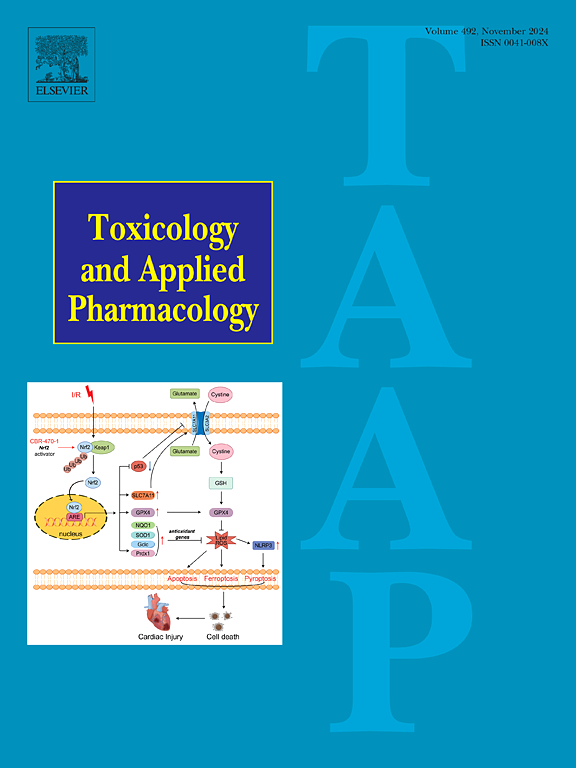戊烯二酸通过适应性诱导狗和大鼠肝脏中的尿苷-5'-二磷酸-葡萄糖醛酸转移酶(UGT)诱导甲状腺的非不良变化,而不是人类。
IF 3.3
3区 医学
Q2 PHARMACOLOGY & PHARMACY
引用次数: 0
摘要
对大鼠和狗进行的一些杀真菌剂戊烯二酸酯的毒理学研究显示,甲状腺的变化极小,且无不良反应,大多高于最大耐受剂量,同时对肝脏也有影响。本出版物以证据权重法结合体内和新方法(NAMs)介绍了其作用模式(MOA)。数据显示,其作用方式是通过核受体 CAR/PXR 激活诱导肝酶、增加甲状腺素 (T4) 代谢和升高促甲状腺激素 (TSH) 水平,导致甲状腺滤泡细胞肥大和甲状腺重量增加。在大鼠、狗和人类肝细胞中进行的体外跨物种试验证明了该 MOA 与人类无关。在暴露于戊苯磺酸盐的大鼠和狗肝细胞中,观察到细胞色素 P450s (CYPs) 和尿苷-5'-二磷酸-葡萄糖醛酸转移酶 (UGTs) 的基因表达和活性增加,T4 清除率和/或 T4 葡萄糖醛酸化/T4-UGT 活性增加。因此,可以断定狗和大鼠肝酶诱导增加与甲状腺效应之间存在因果关系。大鼠肝细胞最为敏感,而缬草醛酸盐不会使人肝细胞中的 T4-UGT 活性或 T4 葡萄糖醛酸化和 T4 清除率增加到车辆对照的 2 倍以上。因此,人体暴露于缬草醛酸不太可能导致 T4 水平下降以及随后的甲状腺和发育神经毒性效应。排除了其他与人类相关的甲状腺作用方式,即抑制脱碘酶 (DIO)、甲状腺过氧化物酶 (TPO) 或碘化钠合酶 (NIS)。由于人类和实验动物在甲状腺稳态方面存在已知的物种差异,而且重要的是,根据所提供的数据,这种由肝酶介导的 MOA 被认为与人类危害评估无关。本文章由计算机程序翻译,如有差异,请以英文原文为准。
Valifenalate-induced non-adverse thyroid changes via adaptive induction of uridine 5′-diphospho-glucuronosyltransferase (UGT) in the liver of dogs and rats but not humans
Some rat and dog toxicology studies with the fungicide valifenalate showed minimal, non-adverse thyroid changes, mostly above the maximum tolerated dose, and concomitantly with liver effects. This publication describes their mode of action (MOA), combining in vivo and new approach methodologies (NAMs), in a weight of evidence approach.
Data demonstrate a MOA of liver enzyme induction via nuclear receptor CAR/PXR activation, increased thyroxine (T4) metabolism and elevated thyroid stimulating hormone (TSH) level, leading to thyroid follicular cell hypertrophy and increased thyroid weight. Non-human relevance of the MOA was demonstrated in in vitro cross species assays in rat, dog and human hepatocytes. Increased gene expression and activity of cytochrome P450s (CYPs) and uridine 5′-diphospho-glucuronosyltransferases (UGTs) were observed in rat and dog hepatocytes exposed to valifenalate, with increased T4 clearance and/or T4 glucuronidation/T4-UGT activity. Therefore, a causal relationship between increased liver enzyme induction and thyroid effects in dogs and rats is concluded. Rat hepatocytes were most sensitive, while valifenalate did not increase T4-UGT activity above 2-fold of vehicle control or T4 glucuronidation and T4 clearance in human hepatocytes. Consequently, valifenalate exposure in humans is unlikely to lead to decreased T4 levels, and subsequent thyroid and developmental neurotoxicity effects. Alternative human-relevant thyroid MOAs were excluded, i.e. inhibition of deiodinases (DIO), thyroperoxidase (TPO) or the sodium iodide symporter (NIS).
Due to known species differences in thyroid homeostasis between humans and laboratory animals and, importantly, based on the presented data, this liver enzyme mediated MOA is considered not relevant for human hazard assessment.
求助全文
通过发布文献求助,成功后即可免费获取论文全文。
去求助
来源期刊
CiteScore
6.80
自引率
2.60%
发文量
309
审稿时长
32 days
期刊介绍:
Toxicology and Applied Pharmacology publishes original scientific research of relevance to animals or humans pertaining to the action of chemicals, drugs, or chemically-defined natural products.
Regular articles address mechanistic approaches to physiological, pharmacologic, biochemical, cellular, or molecular understanding of toxicologic/pathologic lesions and to methods used to describe these responses. Safety Science articles address outstanding state-of-the-art preclinical and human translational characterization of drug and chemical safety employing cutting-edge science. Highly significant Regulatory Safety Science articles will also be considered in this category. Papers concerned with alternatives to the use of experimental animals are encouraged.
Short articles report on high impact studies of broad interest to readers of TAAP that would benefit from rapid publication. These articles should contain no more than a combined total of four figures and tables. Authors should include in their cover letter the justification for consideration of their manuscript as a short article.

 求助内容:
求助内容: 应助结果提醒方式:
应助结果提醒方式:


